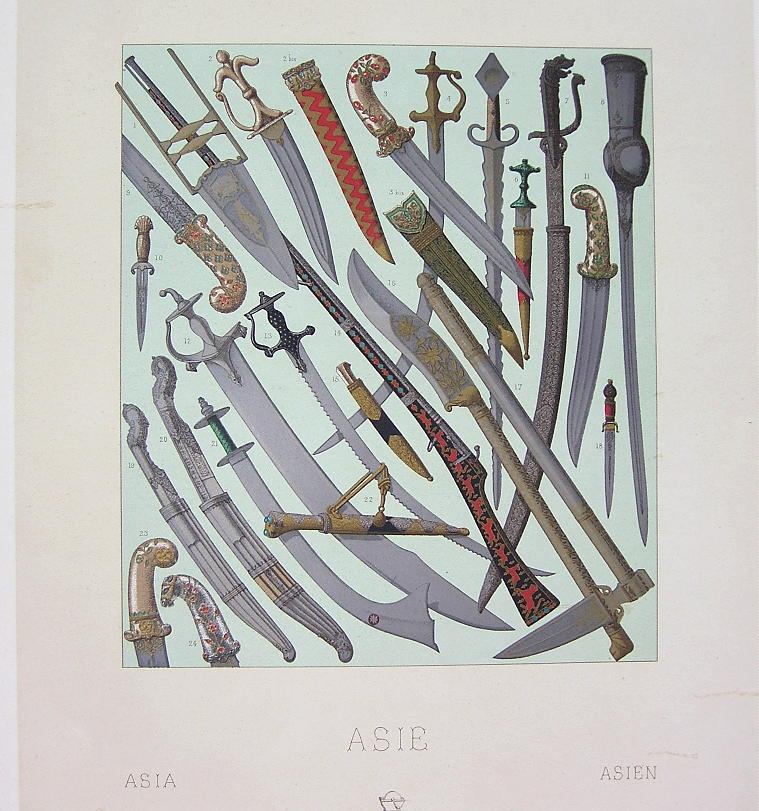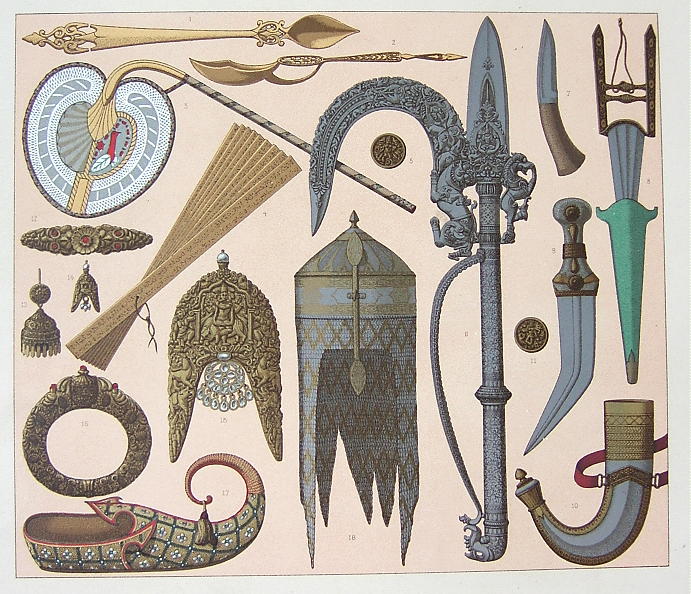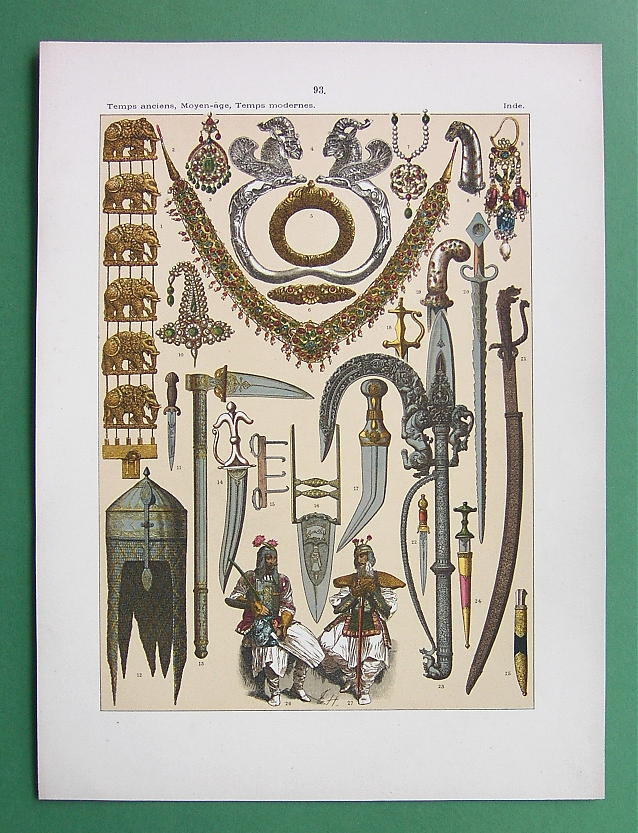TWO VIEWS BY ALBERT RACINET, Paris, 1878

TWO VIEWS BY ALBERT RACINET, Paris, 1878

"Fig. 1. Dagger from India, called khouttar, Fig. 2,3,9,11,23 and 24. Indian daggers with strengthened, rippled blades. Nos. 3,9,11, and 23 have the handle made of ivory, enriched with enameled ornaments. Dagger No. 24 has the handle in the form of a horse-head. It is made of a crystal-rock embellished with enamel. The blades of the luxury daggers are embellished with gold. Fig. 6. Dagger from India slightly projecting from its sheath. The handle is made of green jade, artistically formed. Fig. 10 and 18. These are oriental daggers, made by a Paris company of M. Henri Lepage. Fig. 19 and 20. Indian daggers. The handle has raised design, the sheath has wide furrows. Fig. 22. Dagger from Persia with a cord made of weaved gold threads. Fig. 15. Dagger from Turkey shown inserted in its sheath. Fig. 5. Sword from India, with the blade serrated on both sides. The handle is made of wood. Fig. 8. Sword from India. It has a flat blade and transversal grip, embellished with with a round-shaped armband. In India, this sword is considered already an ancient type of sword. Fig. 4. Sabre from India with a curved blade, steel grip covered with plain gold. Fig. 5. Indian saber. Drawn half-way from its silver sheath. The blade is slightly curved, the cross-guard is hook-shaped, made of finely chiseled silver. The end of the grip is in the form of an animal's head. Fig. 13. Indian saber with curved blade and sharp, saw-like teeth. The grip is embellished with inlay silver. The pommel is in the shape of a small disc. Fig. 12. Indian execution saber. Large and strong Damascus blade, rather rude. This saber weighs almost 13 lbs. Fig. 21. A Special weapon from Nepal called Koukri kora. The blade is hook-shaped, especially at the end, ending with in sharp points. The grip has two discs at both ends. The sheath for this arm is quite large, made of wood. clothed in red velvet. Fig. 14. Old Indian rifle with match-striking fire mechanism. Beautiful barrel inlaid with silver. The grip, made of wood, is lacquered, embellished with gold. Gig. 16. and 17. Shafted weapons made entirely of steel, with reliefs, embellished in gold."

"India, that country full of luxurious vegetation, rich in natural products of every kind, with inexhaustible mines of precious metals and stones, displays her character of overflowing abundance and the fantastic spirit of her inhabitants also in the productions of her art. But notwithstanding her old and comparatively high civilization, a certain conservatism, extending for nearly a thousand years to the social and religious conditions and, institutions, exercised, as a matter of course, its unavoidable influence also on the artistic productions, especially when you look on the caste-like separation of the several trades. Only since the beginning of our century can we report new introductions in the Indian art. Being little conventional and flowing freely, Indian ornament - seems to have the greatest affinity with the Persian style. The surface decoration, never losing its specific character, mostly exhibits a very profuse richness of recurring motives, and a grand splendour of colouring which, far from harassing the eyes of the beholder, affords, on the contrary, a salutary repose to them. The outlines of the design, in which all modelling is avoided, are generally executed on light ground in deeper colours than the pattern itself, and on dark ground-in light colours. The Indians found their principal motives, as seems most likely, among their native plants, employing in the first place lotus, excellently drawn roses, pinks, granates, etc.; but most frequently, especially in modern productions, we meet with the palm-branch always-treated conventionally. Fig. 1 and 2. Wooden spoons from Calcutta used for cream, Fig. 3. Bengalese fan used in Indian homes. The handle is made of wood, the fan part of silk and satin. The first fans used in India were made of palm leaves. They were used against flies, also a tail of the yak (Tibetan steer)) was used for this purpose, Fig. 4. depicts a book made of elongated wooden tablets tied together with a wire, Figs. 5, 11, 12, 13, 14, 15, and 16. depict various buttons, brooches, buckles made of embossed and chiseled gold, embellished with various precious stones, diamonds and pearls, Fig. 6. Antique steel hook used by elephant riders, Fig. 7. Little knife from Nepal, Fig. 8. A khouttar, Indian dagger, distinguished by its sheath covered with velvet. This weapon is only known in Hindustan, Figs. 9 and 10. Another dagger with a bent-shaped blade, strengthened along its length with a raised rib. This type of dagger was not attached to a belt but was carried hanging from it, Fig. 17. Depicts a shoe of a nahab. The fabric is made of golden filaments, embroidered with silk and pearls, Fig. 18. A helmet of a mogul from the 16th Century, the top is highlighted by a pyramid-shaped button, the front has the nose protector."

"Fig. 1,4-6. Arm bands, 2. Necklace, 3,7,10. Head accessories, 8,11,14,17,19,22,24,25. Daggers, 9. Ear-ring,12. Helmet, 13. Battle hammer, 15. Tiger claw, 16. Khouttar with Bull's tongue, 18,20,21. Swords, (20. arab (?)), 23. Elephant's 'sting', 26,27. Princes in a battle attire."